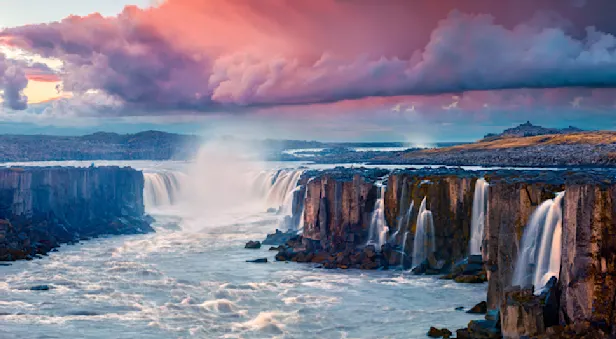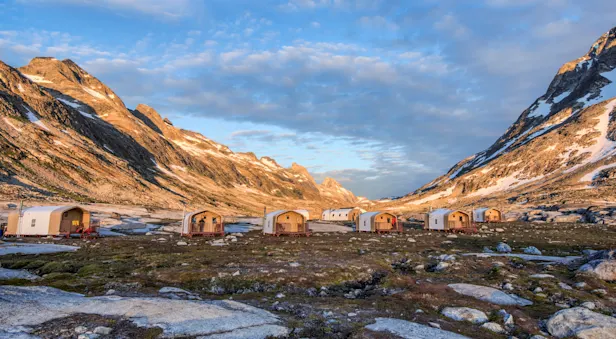What to Pack for a Greenland Adventure
The following packing list contains general recommendations for a Greenland adventure. If you are currently booked on our East Greenland Arctic Adventure or Iceland & Greenland: A Nordic Discovery, please consult your pre-departure materials for the most up-to-date packing list for your trip. You will receive these pre-departure materials 60–90 days before your departure.
Items indicated in color below are typically available in the Nat Hab Gear Store. Please note that due to global supply chain issues beyond our control, we cannot guarantee that every item will always be in stock.
Adventure Guidelines
Water-resistant luggage (optional): While a water-resistant or waterproof luggage is not required, it is recommended as bags may be exposed to rain during transfers. If you do not have one and do not wish to purchase one for this adventure, a good alternative is to place the items in your luggage in some type of waterproof liner. This will ensure that, even if your bag gets wet, your items inside will stay dry.
Waterproof rain gear: We may experience cold and windy temperatures, particularly while on the water in the Zodiacs, so we ask that you be properly prepared. Waterproof rain gear is essential for inclement weather.
Layers: Long underwear base with an insulated jacket and an outer waterproof/windproof layer is far better than a single large jacket. Layers will keep you toasty if outside temperatures are cold, and you can always shed layers if you grow too warm.
The right fabrics: Wool, silk, and synthetic fabrics like polypropylene are superior to cotton because they can trap warm air even when wet. Polar fleece is also a good option. Please remember that down garments lose their ability to insulate when they get wet, so be sure you have a waterproof layer that will fit over any down jackets.
Hats, gloves and socks: Body heat is most likely to be lost from the head, hands and feet; keep them warm and dry with hats, gloves and thermal socks.
Nat Hab Provided Gear
Natural Habitat Adventures will provide the following gear for your use while on the adventure:
Mustang suit
— Mustang suits will be provided in a range of sizes for the Zodiac rides. These suits will keep you warm while on the Zodiacs and during boat transfers.Garden clogs (similar to Crocs)
— We will provide each guest with a pair of comfortable slip-on shoes to wear around camp and in your tent.Sea kayaking equipment
— Includes double or single kayak, paddle, PFD (personal flotation device).Kayaking booties
— Nat Hab will provide neoprene kayaking booties (NRS Comm 3 Wetshoe) as they will be needed for getting in and out of kayaks, and for walking on mud flats and rocky shores. We have sizes ranging from Women’s 6-10 and Men’s 9-13. If you need a different size, please contact our office. And feel free to bring your own pair to ensure better comfort and fit.Paddling gloves
— Nat Hab will provide paddling gloves (sizes S-XL), but you may choose to bring your own to ensure a better fit.Dry suit
—Nat Hab will provide dry suits in a range of sizes for kayaking excursions.Dry bag
— One medium-sized (20 liter) dry bag will be provided for each guest during our excursion to carry items (sunblock, extra layers, etc.). If you plan to bring a camera while kayaking, you may want an additional bag or other sturdy waterproof bag for extra protection from the elements.Mosquito head net
— Mosquitoes and black flies can be present. We will provide you with a head net to ensure your comfort.Trekking poles
— If you choose to bring your own trekking pole(s), make sure they have covers on the ends so they don’t puncture the Zodiacs.Reusable water bottle (included in your pre-trip package)
—In our continuing effort to operate our adventures with as little impact on the environment as possible, you will receive a reusable water bottle (unless you opted out on your Booking Form) to take with you on your adventure. We will provide drinking water throughout the adventure for you to refill your bottle. By doing this, you will avoid using multiple disposable plastic bottles.Lightweight neck gaiter (included in your pre-departure package)
—Provides sun, wind and/or dust protection.
Clothing
Face masks
—High-quality masks such as N95, KN95, or 3-ply surgical masks offer the best protection.Warm jacket (insulated)
— We recommend you bring your warmest synthetic insulated jacket as there is a high potential for rain. A down jacket works too; just be sure it stays dry!Waterproof rain gear
— You will need both a waterproof/Gore-Tex jacket with a hood and Gore-Tex pants. It is extremely important your rain gear be fully waterproof, not just water-repellent, as it can rain frequently and quite heavily in the areas we will be visiting. Flimsy, plastic rain gear is easily torn, rendering it useless for the remainder of the trip, so we recommend you avoid these items when possible. Plastic ponchos are not recommended.
— Bulky ski parkas and ski pants are not practical for this trip. A hard-shell rain jacket made from Gore-tex or another technical waterproof fabric will double as rain and wind protection. Be sure your rain gear is big enough to fit over your fleece and/or down jacket and long underwear or fleece base layers.Waterproof gloves and glove liners
— Waterproof gloves can be helpful should we experience inclement weather. Thin glove liners are highly recommended, as they allow you to take off your gloves and still keeping your hands warm.1-2 warm mid layers (i.e. fleece jacket)
— This should be relatively heavy-weight clothing, as it will be used as your insulation layer, trapping body heat and providing warmth.1-2 pairs of long underwear (tops and bottoms)
— These items should be used for layering and made of light- to medium-weight, moisture-wicking material, such as polypropylene, wool or silk. Cotton is not recommended. Worn as the base layer, they will transport body moisture away from the skin, keeping you comfortable and dry. These can be worn under your hiking pants for additional warmth.1-3 short-sleeved T-shirts
— Greenland can get warm! T-shirts may useful if you are spending additional time in Iceland.1-2 pairs of comfortable hiking pants
1 pair of shorts or lightweight pants
— You might actually wear these on warmer days!Comfortable, warm pants
— Such as fleece, for wearing in the evenings.Underwear
Warm sleepwear
— All tents at Base Camp will have heaters; however, we recommend bringing something warm to sleep in.Swimsuit (optional)
— If you are spending extra time in Iceland and wish to swim in Iceland’s thermal pools or if you wish to participate in an Arctic Polar Plunge!Nice change of clothing (optional)
— Some travelers prefer to have a nicer change of clothing to wear for our welcome and farewell dinners, and for any extra time spent in Reykjavik.3-4 pairs of warm socks
— We suggest socks made of wool or synthetic material—especially for hiking. Cotton socks are not recommended. Bring several combinations of socks to ensure a warm, comfortable fit.Hiking boots
— The Greenland terrain can be tough on your boots, as there are no hiking paths! Your boots should be sturdy, waterproof and comfortable, with good ankle support and traction. Make sure that they have been broken in to prevent blisters.Extra pair of comfortable shoes in case your hiking boots get wet.
Sun hat
— With brim and string, so that it won’t blow away on our boat excursions.Wool or fleece hat
— Essential for cold days in camp, hiking or kayaking.
— Make sure it completely covers your ears!Warm scarf
Sunglasses
— With U.V. filter and strap to secure them. Polarized glasses help you to see through the reflection at the surface of the water and can be very useful while looking for marine life, icebergs and glaciers.
Additional Items
Cash for discretionary gratuities (you may want to bring envelopes for discreet presentation).
— For personal spending (souvenirs, Internet use, food and beverages not included in your trip fee, etc.)Binoculars
— Binoculars are great for this adventure. A good quality pair will enhance your wildlife-viewing experience. Practice using them at home and make a habit of having them with you regularly on the adventure to get the most out of them. Waterproof binoculars work well but are not required.Water-resistant daypack
— To carry equipment/gear during outings.
— A pack cover can help keep contents dry if we get rain.Camera Cover
— To keep your camera setup protected in case of inclement weather.Outlet adapter and/or power converter
Headlamp or flashlight
Toiletries
— Shampoo and soap are provided at Hotel Angmagssalik and Hotel Kulusuk (no conditioner) and shampoo, conditioner and soap are provided at our Reykjavik group hotel. Nat Hab will supply shampoo, conditioner, body wash and hand soap at Base Camp. If you prefer to bring your own shampoo, conditioner or soap to Base Camp, we require that they are made of 100 percent biodegradable ingredients. There are no exceptions as detergents with chemicals will damage the fragile Greenland ecosystem.Sunscreen & lip balm (SPF30+ is essential for the intense sun)
Prescription medications or over the counter
— If you get motion sick, we recommend that you bring your favorite remedy.Insect repellent (non-aerosol)
— Mosquitoes can be a real nuisance at certain times of the Greenland summer and we highly recommend that you come prepared with repellent.Small bottle of hand sanitizer
Prescription glasses/contact lenses
Battery-operated alarm clock or wristwatch
Eye mask (remember, the sun does not set in the summer and early fall)
Earplugs
— These can be very helpful when sleeping in a new environment or if you are sharing accommodations.Reusable waterproof bags
— Great for wet or dirty clothing and to protect camera equipment.Toiletry bag
— Helpful for carrying personal items, since the showers at Base Camp are located outside of your cabin.Eye drops
— Long Zodiac rides can dry out the eyes.Hand/Foot warmers
Hairdryer (optional)
— Provided in guest rooms at the group hotel in Reykjavik and in many rooms at the Angmagssalik and Kulusuk hotels (or can be requested from the front desk). A hairdryer will also be available for use in the shower tent at camp. Please note, however, that there is only enough power to operate one hairdryer at a time.
Travel to Discover Natural Wonders

Iceland: Circling the Land of Fire & Ice
An immersive journey into the rugged grandeur of a land sculpted by intense geological forces. Make a full loop around Iceland on the most comprehensive nature adventure this compact country has to offer.

























